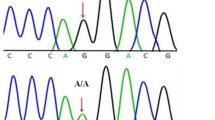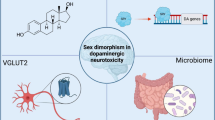Abstract
The vulnerability of dopaminergic neurons to environmental exposures in sporadic Parkinson’s disease (PD) has been attributed to altered detoxification by xenobiotic metabolizing genes. Hence, we investigated the influence of genetic polymorphisms in xenobiotic metabolic pathway (CYP1A1 m1, CYP1A1 m2, CYP1A1 m4, COMT p.H108L, GSTT1, and GSTM1) on the susceptibility to PD. We used PCR–RFLP for CYP1A1 and COMT genotyping; multiplex-PCR for GSTT1 and GSTM1 deletion analysis; and spectrophotometric methods to evaluate the oxidative stress markers. Results showed association of CYP1A1 m1 (OR: 2.38, 95 % CI: 1.76–3.22) and COMT p.H108L (OR: 2.08 95 % CI: 1.56–2.77) polymorphisms with risk for PD. Male patients carrying combination of COMT p.H108L and CYP1A1 m1 variant alleles showed an early onset of the disease. There was a significant increase in oxidative stress makers such as malondialdehyde and protein carbonyls; and decrease in glutathione levels in PD cases compared to controls (P < 0.05). To conclude, CYP1A1 m1, COMT p.H108L polymorphisms were associated with PD risk, and sexual dimorphism was observed in these associations.



Similar content being viewed by others
References
de Lau LM, Breteler MM (2006) Epidemiology of Parkinson’s disease. Lancet Neurol 5(6):525–535
Van Den Eeden SK, Tanner CM, Bernstein AL, Fross RD, Leimpeter A, Bloch DA, Nelson LM (2003) Incidence of Parkinson’s disease: variation by age, gender, and race/ethnicity. Am J Epidemiol 157(11):1015–1022
Warner TT, Schapira AH (2003) Genetic and environmental factors in the cause of Parkinson’s disease. Ann Neurol 53(Suppl 3):16–23
Kurtz JF (1992) An overview of epidemiology of Parkinsonism. In: Hefti F, Weiner WJ (eds) Progress in Parkinson’s disease research. Mount Kisw Futura Publishing, New York, pp 119–169
Asanuma M, Miyazaki I, Ogawa N (2003) Dopamine- or l-DOPA-induced neurotoxicity: the role of dopamine quinone formation and tyrosinase in a model of Parkinson’s disease. Neurotox Res 5:165–176
Jenner P, Olanow CW (1996) Oxidative stress and the pathogenesis of Parkinson’s disease. Neurology 47(6 Suppl 3):161–170
Schapira AH, Cooper JM, Dexter D, Jenner P, Clark JB, Marsden CD (1989) Mitochondrial complex I deficiency in Parkinson’s disease. Lancet 1:1269
Jakoby WB, Ziegler DM (1990) The enzymes of detoxication. J Biol Chem 265(34):20715–20718
Smith CA, Smith G, Wolf CR (1994) Genetic polymorphisms in xenobiotic metabolism. Eur J Cancer 30A(13):1921–1935
Baez S, Segura-Aguilar J, Widersten M, Johansson AS, Mannervik B (1997) Glutathione transferases catalyse the detoxication of oxidized metabolites (o-quinones) of catecholamines and may serve as an antioxidant system preventing degenerative cellular processes. Biochem J 324:25–28
Takakubo F, Yamamoto M, Ogawa N, Yamashita Y, Mizuno Y, Kondo I (1996) Genetic association between cytochrome P450IA1 gene and susceptibility to Parkinson’s disease. J Neural Transm 103:843–849
Stroombergen MC, Waring RH (1999) Determination of glutathione S-transferase mu and theta polymorphisms in neurological disease. Hum Exp Toxicol 18:141–145
Dick FD, De Palma G, Ahmadi A, Osborne A, Scott NW, Prescott GJ, Bennett J, Semple S, Dick S, Mozzoni P, Haites N, Wettinger SB, Mutti A, Otelea M, Seaton A, Soderkvist P, Felice A, Geoparkinson Study Group (2007) Gene-environment interactions in parkinsonism and Parkinson’s disease: the geoparkinson study. Occup Environ Med 64:673–680
Kunugi H, Nanko S, Ueki A, Otsuka E, Hattori M, Hoda F, Vallada HP, Arranz MJ, Collier DA (1997) High and low activity alleles of catechol-O-methyltransferase gene: ethnic difference and possible association with Parkinson’s disease. Neurosci Lett 221(2–3):202–204
Punia S, Das M, Behari M, Dihana M, Govindappa ST, Muthane UB, Thelma BK, Juyal RC (2011) Leads from xenobiotic metabolism genes for Parkinson’s disease among north Indians. Pharmacogenet Genomics 21(12):790–797
Placer ZA, Crushman LL, Johnson BC (1966) Estimation of products of lipid peroxidation (malonylaldehyde) in biochemical systems. Anal Biochem 16(2):359–364
Rajesh M, Sulochana KN, Coral K, Punitham R, Biswas J, Babu K, Ramakrishnan S (2004) Determination of carbonyl group content in plasma proteins as a useful marker to assess impairment in antioxidant defense in patients with Eales’ disease. Indian J Ophthalmol 52(2):139–144
Ellman GL (1959) Tissue sulfhydryl groups. Arch Biochem Biophys 82(1):70–77
Bosco DA, Fowler DM, Zhang Q, Nieva J, Powers ET, Wentworth P Jr, Lerner RA, Kelly JW (2006) Elevated levels of oxidized cholesterol metabolites in lewy body disease brains accelerate alpha-synuclein fibrilization. Nat Chem Biol 2:249–253
Nakabeppu Y, Tsuchimoto D, Yamaguchi H, Sakumi K (2007) Oxidative damage in nucleic acids and Parkinson’s disease. J Neurosci Res 85:919–934
Zeevalk GD, Razmpour R, Bernard LP (2008) Glutathione and Parkinson’s disease: is this the elephant in the room? Biomed Pharmacother 62:236–249
Jenner P (2003) Oxidative stress in Parkinson’s disease. Ann Neurol 53:26–36
Perry TL, Godin DV, Hansen S (1982) Parkinson’s disease: a disorder due to nigral glutathione deficiency? Neurosci Lett 33(3):305–310
Sechi G, Deledda MG, Bua G, Satta WM, Deiana GA, Pes GM et al (1996) Reduced intravenous glutathione in the treatment of early Parkinson’s disease. Prog Neuropsychopharmacol Biol Psychiatry 20(7):1159–1170
Venkateshappa C, Harish G, Mythri RB, Mahadevran A, Barath MMS, Shankar SK (2012) Increased oxidative damage and decreased antioxidant function in aging human substantia nigra compared to striatum: implication for Parkinson’ disease. Neurochem Res 37(2):358–369
Wang J, Liu Z, Chen B (2000) Association between cytochrome P-450 enzyme gene polymorphisms and Parkinson’s disease. Zhonghua Yi Xue Za Zhi 80(8):585–587
Chan DK, Mellick GD, Buchanan DD, Hung WT, Ng PW, Woo J, Kay R (2002) Lack of association between CYP1A1 polymorphism and Parkinson’s disease in a Chinese population. J Neural Transm 109(1):35–39
Kiyohara C, Miyake Y, Koyanagi M, Fujimoto T, Shirasawa S, Tanaka K, Fukushima W, Sasaki S, Tsuboi Y, Yamada T, Oeda T, Shimada H, Kawamura N, Sakae N, Fukuyama H, Hirota Y, Nagai M, Fukuoka Kinki Parkinson’s Disease Study Group (2011) Genetic polymorphisms involved in dopaminergic neurotransmission and risk for Parkinson’s disease in a Japanese population. BMC Neurol 11:89
Lechun L, Yu S, Pengling H, Changqi H (2013) The COMT Val158Met polymorphism as an associated risk factor for Parkinson’s disease in Asian rather than Caucasian populations. Neurol India 61(1):12–16
de Lau LM, Verbaan D, Marinus J, Heutink P, van Hilten JJ (2012) Catechol-O-methyltransferase Val158Met and the risk of dyskinesias in Parkinson’s disease. Mov Disord 27(1):132–135
Klebe S, Golmard JL, Nalls MA, Saad M, Singleton AB, Bras JM, Hardy J, Simon-Sanchez J, Heutink P, Kuhlenbäumer G, Charfi R, Klein C, Hagenah J, Gasser T, Wurster I, Lesage S, Lorenz D, Deuschl G, Durif F, Pollak P, Damier P, Tison F, Durr A, Amouyel P, Lambert JC, Tzourio C, Maubaret C, Charbonnier-Beaupel F, Tahiri K, Vidailhet M, Martinez M, Brice A, Corvol JC, French Parkinson’s Disease Genetics Study Group, International Parkinson’s Disease Genomics Consortium (IPDGC) (2013) The Val158Met COMT polymorphism is a modifier of the age at onset in Parkinson’s disease with a sexual dimorphism. J Neurol Neurosurg Psychiatry 84(6):666–673
Wahner AD, Glatt ChE, Bronstein JM, Ritz B (2007) Glutathione S-transferase mu, omega, pi and theta class variants and smoking in Parkinson’s disease. Neurosci Lett 413(3):274–278
Kelada SN, Stapleton PL, Farin FM, Bammler TK, Eaton DL, Smith-Weller T, Franklin GM, Swanson PD, Longstreth WT Jr, Checkoway H (2003) Glutathione S-transferases M1, T1 and P1 polymorphisms and Parkinson’s disease. Neurosci Lett 337(1):5–8
Perez-Pastene C, Graumann R, Diaz-Grez F, Miranda M, Venegas P, Godoy OT, Layson L, Villagra R, Matala JM, Herrera L, Segura-Aguilar J (2007) Association of GST M1 oxidative changes and possible effects of polymorphism of antioxidant enzymes in neurodegenerative disease null polymorphism with Parkinson’s disease in a Chilean population with strong Amerindian genetic component. Neurosci Lett 418(2):181–185
Stroombergen MC, Waring RH (1999) Determination of glutathione S-transferase mu and theta polymorphisms in neurological disease. Hum Exp Toxicol 18(3):141–145
Menegon A, Board PG, Blackburn AC, Mellick GD, Le Couteur DG (1998) Parkinson’s disease, pesticides, and glutathione transferase polymorphisms. Lancet 352:1344–1346
Mellick GD (2006) CYP450, genetics and Parkinson’s disease: gene x environment interactions hold the key. J Neural Transm Suppl 70:159–165
Author information
Authors and Affiliations
Corresponding author
Rights and permissions
About this article
Cite this article
Kumudini, N., Uma, A., Naushad, S.M. et al. Sexual dimorphism in xenobiotic genetic variants-mediated risk for Parkinson’s disease. Neurol Sci 35, 897–903 (2014). https://doi.org/10.1007/s10072-013-1622-3
Received:
Accepted:
Published:
Issue Date:
DOI: https://doi.org/10.1007/s10072-013-1622-3




